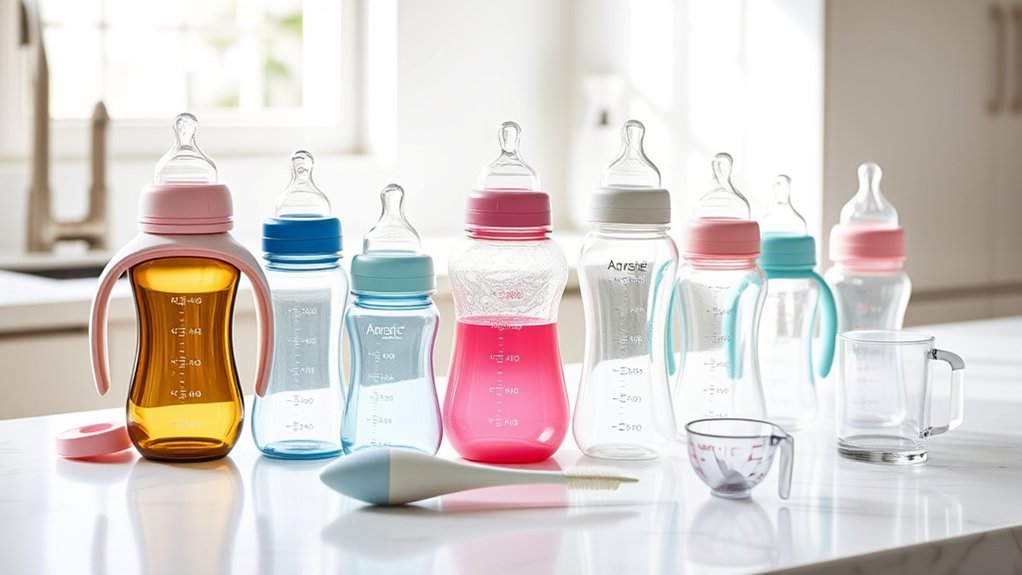Picture a nursery filled with soft colors and gentle sounds, where the right baby bottle can make all the difference in your feeding routine. You might wonder about materials, nipple flow rates, or if anti-colic features are truly necessary. As you navigate these choices, it’s essential to understand how they can impact your baby’s comfort and your convenience. Let’s explore the key factors that will help you make informed decisions for your little one.
What Materials Should I Consider for Baby Bottles?
When you’re choosing baby bottles, it’s essential to evaluate the materials they’re made from, as each option has its pros and cons.
Glass bottles are durable and easy to clean, but they can be heavy and breakable.
Plastic bottles are lightweight and shatterproof, yet some may contain harmful chemicals like BPA, so look for BPA-free options.
Silicone bottles offer flexibility and a soft feel, making them easy for your baby to grip, but check their durability against wear.
Stainless steel is another option, providing excellent insulation and durability, though it can be pricier.
Ultimately, consider your lifestyle, your baby’s needs, and how each material fits into your feeding routine, ensuring you make a safe and practical choice.
How Do I Choose the Right Nipple Flow for My Baby?
Choosing the right nipple flow for your baby is essential for a comfortable feeding experience. You’ll want to evaluate your baby’s age and feeding habits. Newborns typically need a slow flow nipple, as they’re still learning to coordinate sucking and swallowing.
As they grow, you can gradually shift to medium and fast flow nipples. Pay attention to your baby’s cues; if they seem frustrated or tired during feeding, the flow might be too slow. Conversely, if they’re gulping or choking, the flow could be too fast.
It’s also important to check for any leaks or excessive spit-up, which can indicate an inappropriate flow. Finding the right nipple flow takes time, so don’t hesitate to experiment until you find the perfect match.
Are Anti-Colic Bottles Worth the Investment?
Finding the right feeding tools can make a significant difference in your baby’s comfort, especially if they struggle with gas or colic.
Anti-colic bottles are designed to reduce air intake during feeding, which can help minimize discomfort and fussiness. If your little one often seems gassy or irritable after meals, investing in these specialized bottles might be worthwhile.
Many parents report improvements in their baby’s feeding experience, leading to more peaceful feedings for everyone involved. While anti-colic bottles may come with a higher price tag, the potential for less gas-related distress can outweigh the cost.
Ultimately, if your baby benefits from reduced colic symptoms, the investment could be one of the best decisions you make for their well-being.
How Many Bottles Do I Need to Start With?
Getting started with bottle feeding can feel overwhelming, especially when you’re unsure how many bottles you’ll need. A good rule of thumb is to have at least 4 to 6 bottles on hand. This allows you to have a few ready for feeding while others are being cleaned or sterilized.
If you’re exclusively bottle feeding, you might want to reflect on having even more, around 8 to 10 bottles, to guarantee you’re always prepared.
Remember to choose bottles in various sizes, as your baby’s feeding needs will change over time. It’s also helpful to have a mix of nipples with different flow rates. This way, you can easily adapt as your baby grows and their preferences evolve.
When Should I Transition My Baby to a Sippy Cup?
As your baby grows and becomes more adept at handling their feeding routine, the time will come to introduce a sippy cup.
Most experts recommend starting this change around 6 to 9 months, but it’s important to look for signs of readiness. If your baby can sit up well, grasp objects, and show interest in drinking from a cup, they’re likely ready.
Begin by offering small amounts of water or milk in the sippy cup during meal times. Gradually replace bottle feeds with the sippy cup, aiming to fully change by around 12 to 18 months.
Frequently Asked Questions
Can I Use Regular Bottles for Breast Milk Storage?
You can use regular bottles for breast milk storage, but make certain they’re clean and BPA-free. Glass or specific breast milk storage containers are better options, as they preserve milk quality and nutrients more effectively.
How Do I Clean and Sterilize Baby Bottles Properly?
Cleaning baby bottles reduces harmful bacteria by up to 99%. You should wash them with hot, soapy water, then sterilize using boiling water or a microwave sterilizer. Always let them air dry completely before using.
Are There Specific Bottle Brands Recommended by Pediatricians?
Yes, many pediatricians recommend brands like Dr. Brown’s, Philips Avent, and Medela for their safety and effectiveness. It’s best to consult your pediatrician for advice tailored to your baby’s specific needs and preferences.
What Is the Best Way to Warm Baby Bottles?
The best way to warm baby bottles is by placing them in a bowl of warm water for a few minutes. Avoid microwaving, as it can create hot spots and uneven temperatures. Always test the milk’s temperature before feeding.
How Do I Know if a Bottle Is Bpa-Free?
To guarantee a bottle’s BPA-free, look for labels or symbols on the packaging. It’s like searching for a hidden treasure; knowing the right signs brings peace of mind for you and your little one’s health.
Conclusion
Choosing baby bottles is like selecting the right tools for a craftsman. Each material, flow rate, and feature plays a role in nurturing your little one. By understanding your baby’s needs and preferences, you’re not just feeding them; you’re crafting a foundation for their growth. With a handful of bottles and a gentle shift to sippy cups, you create a smooth journey through their early feeding stages. Trust your instincts, and let love guide your choices.
